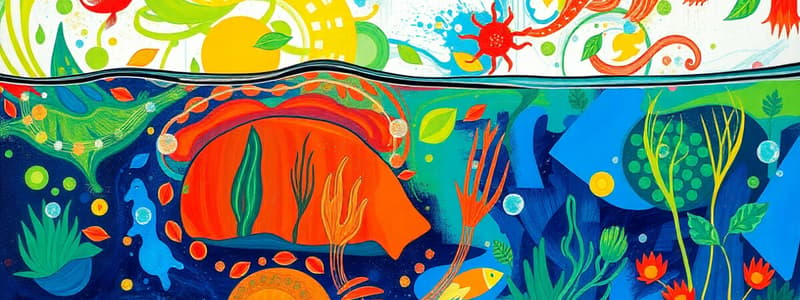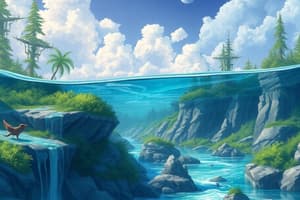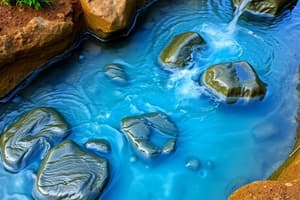Podcast
Questions and Answers
What percentage of Earth's water is found in oceans, seas, and salt lakes?
What percentage of Earth's water is found in oceans, seas, and salt lakes?
- 30%
- 97% (correct)
- 70%
- 1%
Which process of the water cycle contributes to the formation of clouds?
Which process of the water cycle contributes to the formation of clouds?
- Evaporation (correct)
- Precipitation
- Transpiration
- Condensation
Which of the following best describes the hydrosphere?
Which of the following best describes the hydrosphere?
- The total amount of living organisms in a region
- All solid materials found on Earth
- All water on Earth's surface and its gaseous state (correct)
- A layer of gases surrounding the Earth
How does water quality affect living organisms?
How does water quality affect living organisms?
What is the main source of fresh water on Earth?
What is the main source of fresh water on Earth?
Which of the following is NOT a state that water can exist in?
Which of the following is NOT a state that water can exist in?
What is the effect of chemical reactions on water quality?
What is the effect of chemical reactions on water quality?
Which statement about water's unique properties is true?
Which statement about water's unique properties is true?
What is the typical pH range of clouds?
What is the typical pH range of clouds?
Which factor can cause an increase in the acidity of cloud pH levels?
Which factor can cause an increase in the acidity of cloud pH levels?
What is the first step in measuring the pH of water samples using a pH meter?
What is the first step in measuring the pH of water samples using a pH meter?
Why is it important to monitor salinity levels in water bodies?
Why is it important to monitor salinity levels in water bodies?
What is the ratio of hydrogen to oxygen in a water molecule by volume?
What is the ratio of hydrogen to oxygen in a water molecule by volume?
What does the use of pH test strips involve?
What does the use of pH test strips involve?
What contributes to the partial positive charge on the hydrogen atoms in a water molecule?
What contributes to the partial positive charge on the hydrogen atoms in a water molecule?
Which of the following areas is likely to have a different pH level in clouds due to environmental factors?
Which of the following areas is likely to have a different pH level in clouds due to environmental factors?
Which statement about the boiling point of water is true?
Which statement about the boiling point of water is true?
What is the significance of proper waste disposal in relation to water quality?
What is the significance of proper waste disposal in relation to water quality?
What is water's ability to dissolve many salts primarily attributed to?
What is water's ability to dissolve many salts primarily attributed to?
What is the last step in the pH measurement process when using a pH meter?
What is the last step in the pH measurement process when using a pH meter?
What ions exist as a result of hydrolysis in water?
What ions exist as a result of hydrolysis in water?
What effect does acid rain have on the environment?
What effect does acid rain have on the environment?
Why does water not exist in a pure form on Earth?
Why does water not exist in a pure form on Earth?
Which of the following is NOT a consequence of water's polarity?
Which of the following is NOT a consequence of water's polarity?
Flashcards
Hydrosphere
Hydrosphere
The total amount of water on Earth, including oceans, lakes, rivers, groundwater, and ice.
Water Cycle
Water Cycle
The continuous movement of water on, above, and below the Earth's surface, involving evaporation, condensation, precipitation, and runoff.
Evaporation
Evaporation
The process where liquid water changes into water vapor and rises into the atmosphere.
Condensation
Condensation
Signup and view all the flashcards
Precipitation
Precipitation
Signup and view all the flashcards
Runoff
Runoff
Signup and view all the flashcards
Groundwater
Groundwater
Signup and view all the flashcards
Frozen Water
Frozen Water
Signup and view all the flashcards
Acid Rain Formation
Acid Rain Formation
Signup and view all the flashcards
Chemical Composition of Water
Chemical Composition of Water
Signup and view all the flashcards
Water Polarity
Water Polarity
Signup and view all the flashcards
Hydrogen Bonds in Water
Hydrogen Bonds in Water
Signup and view all the flashcards
Dissolving Salts in Water
Dissolving Salts in Water
Signup and view all the flashcards
Hydrolysis
Hydrolysis
Signup and view all the flashcards
High Boiling Point of Water
High Boiling Point of Water
Signup and view all the flashcards
pH of Water
pH of Water
Signup and view all the flashcards
What is pH?
What is pH?
Signup and view all the flashcards
What is the typical pH of clouds?
What is the typical pH of clouds?
Signup and view all the flashcards
How do human activities affect cloud pH?
How do human activities affect cloud pH?
Signup and view all the flashcards
What is hydrolysis of salts?
What is hydrolysis of salts?
Signup and view all the flashcards
What is salinity?
What is salinity?
Signup and view all the flashcards
Why is pH monitoring important?
Why is pH monitoring important?
Signup and view all the flashcards
How does waste disposal affect water quality?
How does waste disposal affect water quality?
Signup and view all the flashcards
What is the purpose of measuring pH in different water samples?
What is the purpose of measuring pH in different water samples?
Signup and view all the flashcards
Study Notes
Aquatic Ecosystem: Water Quality
- Water is a vital liquid medium where many chemical reactions occur, affecting living organisms.
- Water exists in all three states (solid, liquid, gas) at temperatures found on Earth.
- Water is essential for life processes, dissolving chemicals and transporting substances within living cells.
- The hydrosphere encompasses about 70% of Earth's surface, primarily oceans and seas (97%).
- Fresh water exists in rivers, lakes, groundwater, and glaciers (approximately 1%).
- Egypt has diverse aquatic environments, including the Nile River, Red Sea, Gulf of Suez, etc.
Water Cycle
- Water is in constant motion and change between its states (solid, liquid, gas).
- The water cycle involves evaporation, cloud formation, rain/snowfall, and processes like transpiration.
- Water interacts with the air, forming acid rain that decomposes rocks.
- Underground water filtering occurs through soil and sedimentary rock pores.
Chemical Structure of Water
- Water molecules are composed of two hydrogen atoms and one oxygen atom (H₂O).
- Oxygen has a higher electronegativity, drawing electrons towards it, creating a polar molecule.
- Water's polarity allows it to dissolve many salts and minerals.
- Water's ability to form hydrogen bonds is crucial for its high boiling point compared to similar compounds.
Hydraulic Reactions
- Hydrolysis is a chemical reaction where water reacts with other compounds.
- Examples include the reaction of table salt (NaCl) with water, resulting in sodium (Na⁺) and chloride (Cl⁻) ions in solution.
- Hydrolysis of some salts in water can determine acidity or alkalinity.
- Sodium bicarbonate (NaHCO₃) hydrolysis increases hydroxide ion concentration.
- Ammonium chloride (NH₄Cl) hydrolysis increases hydrogen ion concentration.
Acid-Base Balance and pH
- Acid-base balance in water depends on the relative concentrations of hydrogen (H⁺) and hydroxide (OH⁻) ions.
- pH is a measure of acidity or basicity. The scale ranges from 0 to 14.
- Pure water has a neutral pH of 7.
- Seawater pH typically ranges from 7.5 to 8.4.
- Fresh water (rivers and lakes) has a pH that commonly ranges from 6.5 to 8.5.
- pH in different water sources (including groundwater, clouds) can vary based on factors like rock structure, salts, and industrial activity.
Practical Activity
- Measuring pH involves using a pH meter or test strips.
- Data collection on water samples (seawater, river water, spring water) allows for comparisons.
- Research on different pH values in clouds and rainfall in diverse regions (industrial, agricultural, coastal) can reveal causes of variation.
- Maintaining water quality is crucial for living organisms and ecosystems.
Studying That Suits You
Use AI to generate personalized quizzes and flashcards to suit your learning preferences.




